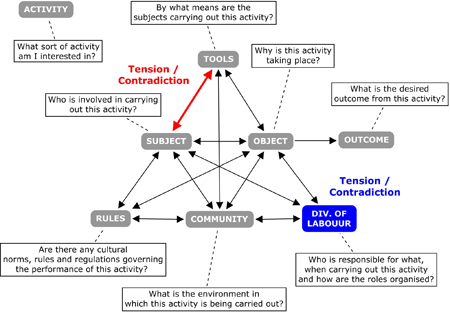Using CmapTools to Construct Activity Systems
I’ve recently got to the stage that will be recognisable to many researchers who are using 3rd generation Activity Theory in their research; that is, drawing activity system triangles at every available opportunity – notepads, backs of envelopes, beer mats, in my sleep etc.
However organic and spontaneous this approach might be, the need for consistency, and to communicate activity systems to participants, supervisors and wider audiences, invariably necessitates developing digital methods of construction. Furthermore, the fine-grained approach I am taking with my research requires constructing numerous interrelated activity systems to represent shifting patterns of practice across contexts and timeframes.
Whilst I looked into a range of drawing programmes for this task, I’ve actually ended up adopting the use of a concept mapping programme. A desktop-based freeware from the Institute of Human and Machine Cognition (IHMC), CmapTools was originally devised by concept mapping pioneers including Alberto J. Cañas and Joseph D. Novak around cognitive studies based primarily on Ausebal’s Assimilation Theory.
I’d be interested in hearing what other researchers use to draft their activity systems. In the meantime, here are some key tips on using CmapTools for this purpose:
Drafting the Activity System
By default, CmapTools automatically creates a link between two nodes to facilitate standard concept mapping notation. Override this by holding down the Shift key whilst dragging the link.
Applying Styles
Styles are applied to text, nodes and links (font, colour, shape, thicknesses etc.) A really useful feature is the ability to copy and paste styles (accessed through right clicking) to one or more components, enabling consistent design within and across different activity systems.
Nesting Nodes
Once a basic activity system is constructed, it’s useful to be able to group all components, through the nested node feature (Tools > Nested Nodes > Create). Once created, nested nodes can be collapsed into a single node, which is useful for copying and storing lots of Activity Systems in a single file. Nested nodes can be ‘un-nested’ at any time (Tools > Nested Nodes > Detach Children).
Developing the Activity System
I use nodes with and without links as labels to annotate the activity systems (the prompts shown here are based on Mwanza’s (2001) Eight-Step-Model). According to Yamagata-Lynch (2010), tensions and contradictions can occur at nodes and in the intersections between nodes. I find it useful to use colour codes to identify specific occurrences, though other styles could be applied.
Outputs
Whilst CmapTools does not have transferability of a vector programme such as Adobe Illustrator, content can be printed directly from a file, or saved as image files and PDFs (click on the image above.)
References
Mwanza, D. (2001). Challenges of designing for collaborative learning in an organisation. International Conference on Computers and Learning 2001 (CAL 2001), 2-4 April 2001, University of Warwick.
Yamagata-Lynch, L. C. (2010). Activity Systems Analysis Methods: Understanding Complex Learning Environments. New York: Springer.
Tags: activity theory



January 7th, 2011 at 5:49 pm
[…] This post was mentioned on Twitter by antonella esposito. antonella esposito said: RT @andycoverdale: New blog post – Using CmapTools to Construct Activity Systems | PhD Blog (dot) Net http://bit.ly/h9p6Rw #ActivityTheory […]
January 7th, 2011 at 6:29 pm
I found cmap software difficult to manipulate. Recently I’ve been experimenting with Prezi. It is easy to embed processes, and extend and link nodes. But I haven’t been able to over lay diagrams.
January 7th, 2011 at 7:58 pm
[…] are open ended. I have been trying to visually map these entities to make sense of them, and seeing Andy Coverdale‘s blog entry today (on mapping activity systems) encouraged me to post my mindmap of this […]